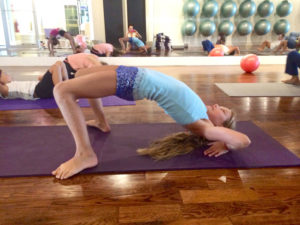By John M. de Castro, Ph.D.
“As those of us with good vision can imagine, the loss of something that helps the function of our body and mind can cause a lot of stress, depression, anxiety and sleep deprivation. Well, guess what has been proven to help those who can see with the similar symptoms? Yep, yoga.” – Julie Phillips-Turner
Visual impairment is quite common among children and adolescents. “According to the 2014 American Community Survey, there are approximately 543,893 children with vision difficulty in the U.S. According to the 2014 ACS, there are 261,413 girls and 282,480 boys under the age of 18 that have vision difficulty in the U.S.” – American Foundation for the Blind. Due to the impaired vision and its impact on movements and physical activities, the visually impaired children generally have lower fitness levels, including deficits in muscular strength and balance.
Yoga practice has been found to improve muscular strength and balance in adults with visual impairment. In today’s Research News article “Yoga Practice Increases Minimum Muscular Fitness in Children with Visual Impairment.” See:
or below or view the full text of the study at:
http://www.ncbi.nlm.nih.gov/pmc/articles/PMC4699502/
Mohnaty and colleagues examine the effectiveness of yoga practice to improve muscular strength in 9-16-year old children. They randomly assigned students at a school for the blind to either a yoga practice group or a wait-list control group. The yoga practice consisted of breathing exercises, loosening practices, postures, relaxation and meditation and was practiced for 60 minutes, 5 days per week for 16 weeks. The wait-list control group participated in a vocational training program instead of yoga practice.
The students were assessed before during and after the 16-week practice period with the Kraus-Weber test of muscular fitness which includes assessments of abdominal with psoas muscles, upper abdominal without psoas muscles, lower abdominal with psoas muscle, upper back muscles, lower back muscles and back and hamstrings. the Kraus-Weber test is a pass or fail test and if the student failed on any of its six components then they were considered as failing the whole test. They found that by the end of the 16-week practice period that the yoga group had significantly fewer failures of the Kraus-Weber test than the control group. Before practice only 12.2% of the children in the yoga group passed the test. But, by the end of the practice period 97.6% of the children passed while only 64.1% of the control group passed.
The study provides clear evidence that practicing yoga can improve muscular fitness in visually impaired children. This is important as the lack of fitness has health consequences for the children and can lead to increased levels of falls and injuries. In addition, yoga practice is known to be safe and to have a wide variety of physical and psychological benefits.
So, improve fitness in visually impaired children with yoga.
“It’s hard at first, and then they get it. We use the edge of the mat for alignment during the practice. We also do the same sequence of poses each week, which does a lot of work on the floor, and some standing poses, including tree pose. The key is to go slowly and use ujaii breath to help center their weight, and stabilize while keeping their attention inward.” Pam Jeter
CMCS – Center for Mindfulness and Contemplative Studies
This and other Contemplative Studies posts are also available on Google+ https://plus.google.com/106784388191201299496/posts
Study Summary
Mohanty, S., Venkata Ramana Murty, P., Pradhan, B., & Hankey, A. (2015). Yoga Practice Increases Minimum Muscular Fitness in Children with Visual Impairment. Journal of Caring Sciences, 4(4), 253–263. http://doi.org/10.15171/jcs.2015.026
Abstract
Introduction: Muscle strength, a component for balance, gait and functional mobility is vital for children with visual impairment. Yoga has frequently been demonstrated to improve physical and mental fitness in children. This study aimed to assess the effect of 16 weeks yoga training on muscular fitness in children with visual impairment.
Methods: This was a wait-listed two-armed-matched case–control study. Eighty (41 yoga, 39 control) visual impairment students of both genders aged 9-16 years matched on age, gender and degree of blindness were assessed at pre, mid (after 8 weeks) and post (after 16 weeks) yoga intervention using the Kraus-Weber test.
Results: The percentage of students passed in yoga group were 12.2%, 43.9% and 68.3% whereas percentages in the control group were 23.1%, 30.8% and 30.8% in pre, mid, and post tests respectively. McNemar test showed significant differences between pre and mid, mid and post in the yoga group while those parameters were not significantly different in the control group. Yoga therapy seemed to have considerable benefits for the children’s muscular fitness.
Conclusion: The study suggests that yoga have considerable benefits for improvement of fitness level in children with visual impairment and may be recommended as and effective, alternative, inexpensive low risk training activity option for them.
http://www.ncbi.nlm.nih.gov/pmc/articles/PMC4699502/
